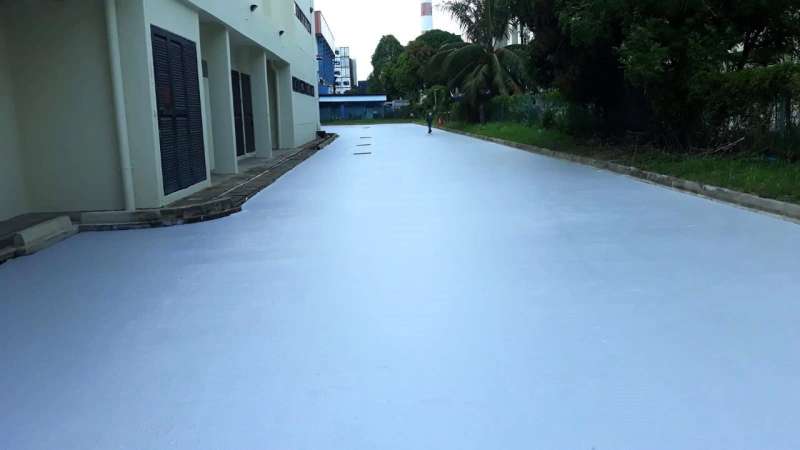This article has been reviewed according to Science X's editorial process and policies. Editors have highlighted the following attributes while ensuring the content's credibility:
fact-checked
trusted source
proofread
Cool paint coatings help pedestrians feel up to 1.5°C cooler in urban setting, field study finds

A real-world study by researchers at NTU Singapore has shown that the use of cool paint coatings in cities can help pedestrians feel up to 1.5°C cooler, making the urban area more comfortable for work and play. The study is published in Sustainable Cities and Society.
Cool paint coatings contain additives that reflect the sun's heat to reduce surface heat absorption and emission. They have been touted as one way to cool down the urban area and mitigate the urban heat island (UHI) effect, a phenomenon in which urban areas experience warmer temperatures than their outlying surroundings.
To date, most studies of cool paint coatings have been either simulation-based or tested in scaled-down models, and understanding of its application in real-world scenarios is limited.
Now, NTU researchers have conducted a first of its kind real-world study in the tropics to comprehensively evaluate how well cool paint coatings work in reducing city heat.
The team coated the roofs, walls, and road pavements of an industrial area in Singapore and found that by comparison with an adjacent uncoated area, the coated environment was up to 2°C cooler in the afternoon, with pedestrian thermal comfort level improving by up to 1.5°C, measured using the Universal Thermal Climate Index—a common international standard for human outdoor temperature sensation that takes into account temperature, relative humidity, thermal radiation, and wind speed.
Lead author Dr. E V S Kiran Kumar Donthu, who completed the work as a Research Fellow at Energy Research Institute at NTU (ERIAN), said, "Our study provides evidence that cool paint coatings reduce heat build-up and contribute to the cooling of the urban environment.
"This is a minimally intrusive solution for urban cooling that has an immediate effect, compared to other options that often require major urban redevelopment to deploy. Moreover, by reducing the amount of heat absorbed in urban structures, we also reduce heat load in buildings, consequently reducing indoor air-conditioning energy consumption."
Lead investigator, Associate Professor Wan Man Pun at the NTU School of Mechanical & Aerospace Engineering (MAE), said, "Findings from the study are not just relevant for cities in Singapore where it is hot all year round, but for other urban areas around the world too. With global warming, people will increasingly look for ways to stay cool. Our study validates how cool paint coatings can be a strategy to reduce the urban heat island effect in future."
The study supports the NTU 2025 strategic plan, which seeks to address humanity's grand challenges on sustainability and accelerate the translation of research discoveries into innovations that mitigate human impact on the environment.
Real-world experiments in 'street canyons'
To carry out their real-world experiments, the NTU researchers selected four rectangular buildings that created two parallel "street canyons"—narrow streets flanked by buildings—in an industrial estate west of Singapore managed by JTC Corporation.
One canyon, or "cool canyon" was coated with cool paints on the roofs, walls, and road pavement, while the other (conventional) canyon remained as it was as a "control" for the experiment.
Using environmental sensors, the NTU team monitored the conditions in the two canyons over two months, which included air movement, surface and air temperature, humidity, and radiation, to see how well the cool paint coatings worked in reducing city heat.
The researchers found that during a 24-hour cycle, the cool canyon saw up to a 30% reduction in heat released from the built-up surfaces, resulting in the air temperature in the cool canyon being cooler than the conventional canyon by up to 2°C during the hottest time of the day, at around 4pm. As a result, pedestrians in the cool canyon can feel up to 1.5°C cooler.
The NTU research team also found that air temperature in the cool canyon was lowered because less heat was absorbed by and stored in the building walls, roofs, and roads, and which would subsequently have been released to either heat up the surrounding air or the building's interior.
Compared to conventional roofs, the roofs with the cool paint coating reflected 50% more sunlight and absorbed up to 40% less heat as a result, during the hottest time of a sunny day. The coated walls also prevented most of the heat from entering the industrial buildings.
Co-author, Assistant Professor Ng Bing Feng at the NTU School of MAE, said, "Our study showed that cool paint coating on the road significantly helped lower the hottest temperatures in the cool canyon, confirming that cool paint coating can be a promising way to make urban areas cooler and more comfortable, especially during hot weather. We hope findings from our study will encourage more urban planners to adopt cool paint coatings on more built-up surfaces, on a large scale."
In future research, the NTU team will focus on how the cool paint coating holds up over time in the same experiment location.
More information: E. V. S. Kiran Kumar Donthu et al, Dynamics of cool surface performance on urban microclimate: A full-scale experimental study in Singapore, Sustainable Cities and Society (2024). DOI: 10.1016/j.scs.2024.105218
Provided by Nanyang Technological University





















